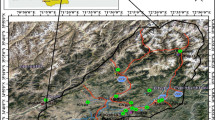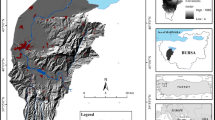Abstract
River Perkerra catchment with an area of 1207 km2 is drained by River Perkerra, which is one of the rivers flowing into Lake Baringo whose drainage area is 6820 km2. The lake is in a semi-arid area of Kenya. Its depth has reduced from 8 m in 1972 to 2.5 m in 2003 due to siltation resulting from high erosion rates in the catchment. The entire catchment is characterised by very steep slopes on the hillsides and gentle slopes in the middle and lower reaches where the surface is bare with very little undergrowth. Interventions to control soil erosion in this fragile ecosystem have been limited partly because of lack of data on erosion and its spatial distribution. In the present study, Universal Soil Loss Equation (USLE) was used in conjunction with GIS Arc/Info and Integrated Land and Water Information Systems (ILWIS) to estimate potential soil loss from River Perkerra catchment. Various physical parameters of the equation were derived by analysing spatial data and processing Landsat TM satellite imagery of the catchment. The estimated potential soil erosion from the catchment was 1.73 million tonnes/year while the sediment yield at the catchment outlet was found to be 1.47 million tonnes/year. The sediment delivery ratio derived using an empirical equation was 0.83. This figure indicates that a higher proportion of sediments generated in the catchment is delivered at the outlet. The use of GIS enabled the results of erosion potential to be mapped back onto the catchment. This is useful in identifying priority areas that require urgent management interventions in controlling soil erosion.
Similar content being viewed by others
References
Baba, S. M. J. and Yusof, K. W., 2001, ‘Modelling soil erosion in tropical environments using remote sensing and geographical informations systems’, Hydrologic. Sci. J. 46(1), 191–198.
Berfield, B. J., Warner, R. C. and Haan, C. T., 1981, Applied Hydrology and Sedimentology for Disturbed Areas, Oklahoma Technical Press, Oklahoma.
Herlocker, D., Shaabani, S. B. V., Sybella, W., 1994, Range Management Handbook of Kenya, Vol. II, 6, Baringo District, Ministry of Agriculture, Livestock Development and Marketing, Nairobi, Kenya.
Hudson, N., 1985, Soil Conservation, Batsford Academic and Educational, London.
Jain, M. K. and Kothyari, U. C., 2000, ‘Estimation of soil erosion and sediment yield using GIS’, Hydrologic. Sci. J. 45(5), 771–786.
Jain, S. K., Kumar, S. and Varghese, J., 2001, ‘Estimation of soil erosion for Himalayan watershed using GIS technique’, Water Resour. Manage. 15, 41–54.
Kirkby, M. J. and Morgan, R. P. C., 1980, Soil Erosion, Wiley, New York.
Morgan, R. P. C. and Davidson, D. A., 1991, Soil Erosion and Conservation, Longman Group, U.K.
Lal, R., 1988, Soil Erosion Research Methods, Soil and water conservation society, Ankey, Iowa.
Louriro, N. S. and Coutinho, M. A., 2001, ‘A new procedure to estimate the RUSLE EI30 index, based on monthly rainfall data and applied to Algarve region, Portugal’, J. Hydrol. 250, 12–18.
Pencol Engineering Consultants Ltd., 1981, Central Baringo Water Development Plan 1983–2003, Preliminary Design Study, 4 Vols., Ministry of Water Development, Government of Kenya.
Renschler, C., Diekkrüger, B. and Mannaerts, C., 1997, ‘Regionalization in surface runoff and soil erosion risk evaluation’, in Regionalization of Hydrology, IAHS Publishers, UK, 254, 233–241.
Singh, V. P. (ed.), 1995. Computer Models of Watershed Hydrology, Water Resources Publication, Colorado.
Speraberry, J. A. and Bowie, A. J., 1969, ‘Predicting sediment yields from complex watersheds’, Trans. ASAE 12, 188–201.
Walling, D. E., 1983, ‘The sediment delivery problem’, J. Hydrol. 65, 209–237.
Wenner, C., 1981, Soil Conservation in Kenya, Ministry of Agriculture, Nairobi, Kenya.
Williams, J. R. and Berndt, H. D., 1972, ‘Sediment yield computed with Universal equation’, J. Hydraul. Div. ASCE 98(HY2), 2087–2098.
Author information
Authors and Affiliations
Corresponding author
Rights and permissions
About this article
Cite this article
Onyando, J.O., Kisoyan, P. & Chemelil, M.C. Estimation of Potential Soil Erosion for River Perkerra Catchment in Kenya. Water Resour Manage 19, 133–143 (2005). https://doi.org/10.1007/s11269-005-2706-5
Received:
Accepted:
Issue Date:
DOI: https://doi.org/10.1007/s11269-005-2706-5




